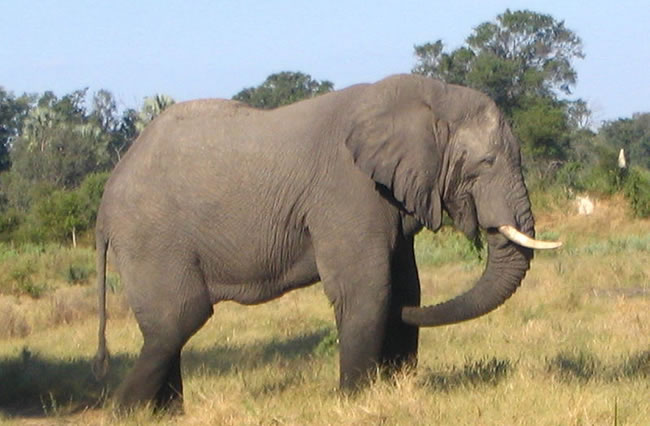|

Description |
| |
| The African elephant is the world's largest living land animal. Males can be twice as large as females and may reach weights of over 14,000 pounds (7 tons). African elephants can stand 13 feet at the shoulder and can be 24 feet long. Elephants are large, gray mammals with thick skin, large ivory tusks and a useful trunk. The trunk is a specially adapted elongation of the nose or upper lip. It is used for breathing, smelling, grasping, pulling, plucking and showering. The trunk of an African elephant has two small finger-like appendages that help to manipulate objects. African elephants are larger than Asian elephants but are best told by their massive ears. |
| |
Diet |
| |
Like most of the heavier animals on Earth, elephants are strictly herbivorous. They eat large quantities (300 pounds per day) of leaves, grass and other vegetation.
|
| |
Habitat and Range |
| |
| African elephants are found in the forests, scrublands, savannas and wetlands of sub-Saharan Africa. |
| |
Breeding |
| |
| Females give birth to a single young (265 pounds) after a gestation period of 22-24 months, the longest of any mammal on Earth. Female elephants, like humans, are one of the few animals in which the female outlives her reproductive years (for elephants about 45 years). After an elephant can no longer give birth, she will help raise young elephants within the herd. Young elephants stay with their mothers for up to 9 years. Female elephants and their daughters may form bonds that last the lengths of their lives. |
| |
Behavior |
| |
The African elephant has a fascinating social system. Herds are matriarchal - which means they are led by the oldest and largest female. Such herds usually consist of 10 closely related females and their young. The matriarch sets the pace of the herd and gives it direction. She also determines whether or not the herd flees or defends itself. She is vital to the success of the herd. When the matriarch is shot by poachers, the herd becomes chaotic and confused, but when she gets too old or sick, she is replaced by the next oldest elephant in the herd. Males only join the herd during breeding season.
African elephants communicate through a wide range of sounds, grunts, whistles and trumpeting sounds. Elephants are capable of producing low-pitched sounds that help them communicate from several miles away. Such sounds are of such low frequency that humans cannot hear them. |
| |
Status |
| |
| The African elephant has been persecuted for their ivory tusks by poachers. Most countries in Africa had suffered at least an 80% decline in elephant populations by 1986. In response, several countries imposed a moratorium (ban) on ivory products, including the United States. Since the moratorium, populations of African elephants have responded well. They now face the threat of habitat destruction as human population growth squeezes more and more elephants out of their preferred habitat. |
| |
|